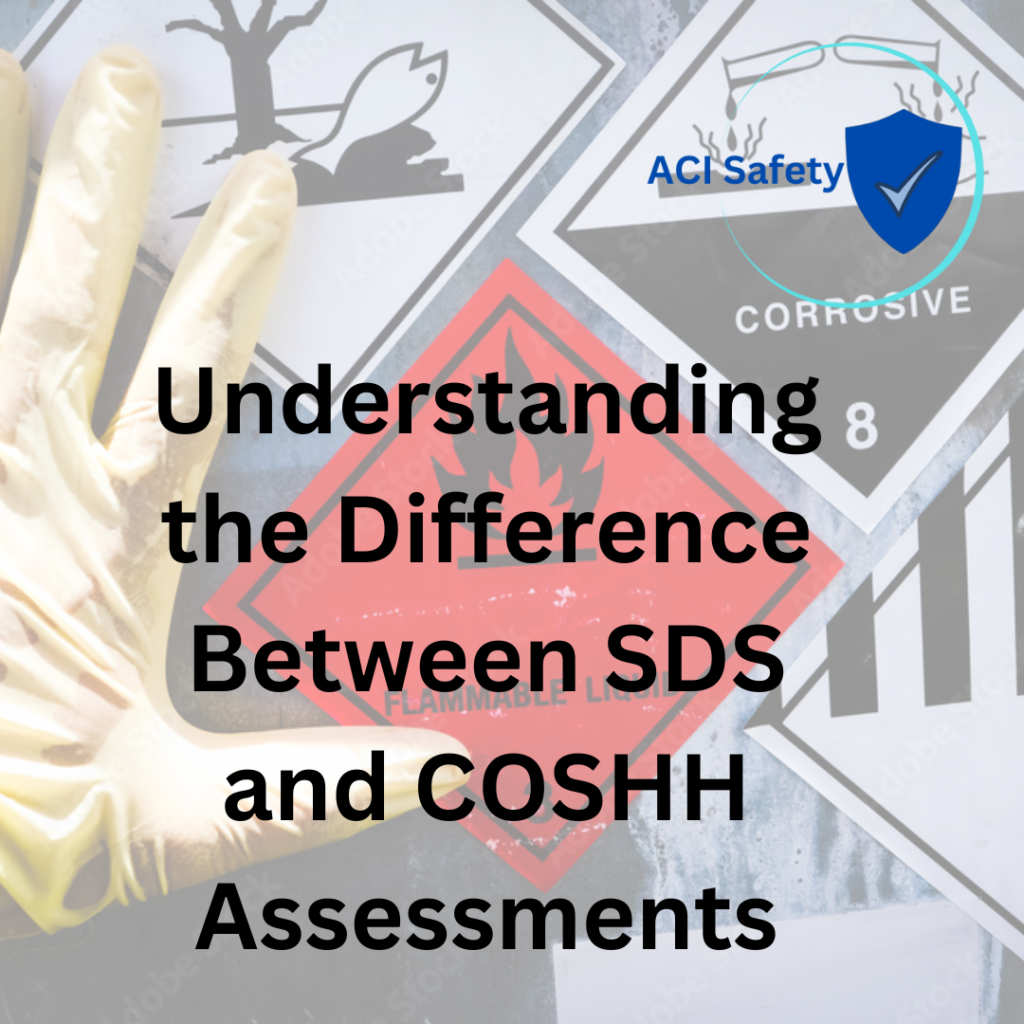Understanding the Difference Between SDS and COSHH Assessments
When it comes to managing chemical safety in the workplace, confusion between SDS (Safety Data Sheets) and COSHH (Control of Substances Hazardous to Health) assessments is all too common. While these tools work closely together, they serve distinct purposes.
What Are Safety Data Sheets (SDS)?
An SDS, sometimes called an MSDS (Material Safety Data Sheet), is essentially a detailed guide to a chemical. Think of it as the “encyclopaedia” for that substance, created by the manufacturer to provide crucial information on how to handle, store, and respond to emergencies involving the product.
Key Components of an SDS
SDS documents are standardised into 16 sections covering:
- Identification: Provides the name of the chemical, its intended uses, and the supplier’s contact details. Helps users identify the substance and contact the manufacturer if needed.
- Hazard Identification: Describes the chemical’s hazards and associated risks. Includes hazard classifications, warning labels, and precautionary statements.
- Composition/Information on Ingredients: Lists the chemical’s components, including hazardous ingredients and their concentrations. Essential for identifying harmful substances.
- First-Aid Measures: Details what to do in case of exposure (e.g., inhalation, skin contact, eye contact, or ingestion). Includes emergency response instructions.
- Firefighting Measures: Provides information on dealing with fires involving the chemical, including suitable extinguishing methods and potential hazards.
- Accidental Release Measures: Explains how to manage spills or leaks safely. Includes containment, cleanup procedures, and precautions to protect people and the environment.
- Handling and Storage: Describes how to safely handle and store the chemical, including specific conditions like temperature, ventilation, and incompatibilities.
- Exposure Controls/Personal Protection: Outlines safe exposure limits and recommends personal protective equipment (PPE) like gloves, goggles, and respirators.
- Physical and Chemical Properties: Lists the chemical’s key physical and chemical characteristics, such as boiling point, pH, flashpoint, and solubility.
- Stability and Reactivity: Highlights how stable the chemical is under normal conditions and identifies potential reactions or incompatibilities.
- Toxicological Information: Details the health effects of the chemical, including symptoms of exposure, acute and chronic effects, and toxicity data.
- Ecological Information: Explains the chemical’s impact on the environment, including its potential to harm aquatic life, persist in ecosystems, or bioaccumulate.
- Disposal Considerations: Provides guidelines for the safe and compliant disposal of the chemical and its packaging.
- Transport Information: Covers safe transportation practices, including hazard classifications, packing instructions, and regulations for shipping.
- Regulatory Information: Lists specific regulations or laws applicable to the chemical, such as EU REACH or UK COSHH compliance requirements.
- Other Information: Includes any additional relevant details, such as preparation or revision dates, and references to key documents or standards.
Why SDS Matter
The SDS acts as a communication tool, bridging the knowledge gap between the manufacturer and the end user. It informs the user about risks and proper precautions but doesn’t account for specific workplace conditions. This is where COSHH assessments come in.
What Are COSHH Assessments?
COSHH assessments are required under UK law to ensure safe handling of hazardous substances. They build on the information from the SDS but adapt it to your specific workplace and practices.
Key Differences Between SDS and COSHH
- Purpose: SDS provides generic product information; COSHH tailors this information to specific workplace scenarios.
- Ownership: The SDS is created by the manufacturer, while the COSHH assessment is the employer’s responsibility.
- Function: SDS informs; COSHH assesses and implements controls.
Key Differences Between SDS and COSHH
SDS
COSHH
Steps to Conducting a COSHH Assessment
A well-structured COSHH assessment involves the following key stages:
- Identify Hazardous Substances Start by identifying the chemicals used in your workplace. The SDS will be a vital reference here, listing the hazards associated with each substance.
- Evaluate the Risks Consider how the substance is used in your specific setting. For example:
- Who is exposed? Think about employees, contractors, or visitors.
- How are they exposed? Consider inhalation, skin contact, ingestion, etc.
- Frequency of exposure? Is it occasional or continuous?
- Decide on Control Measures Using guidance from the SDS, implement practical safety measures:
- Use personal protective equipment (PPE) such as gloves or masks.
- Employ engineering controls like fume hoods or ventilation.
- Minimise exposure through safe handling and proper storage.
- Document and Review Record your findings and update assessments regularly or when changes occur, such as introducing new chemicals or processes.
Why Copying SDS into COSHH Assessments Falls Short
A common mistake is directly copying information from the SDS into a COSHH assessment without further evaluation. While this might pass audits, it leaves gaps in risk management and could fail under legal scrutiny if an incident occurs.
For example, an SDS may recommend overly cautious PPE measures that are impractical in your setting. Tailoring these to your situation ensures compliance while maintaining a practical, safe work environment.
Practical Example: Paint Application – Brushing vs. Spraying
Let’s consider a scenario where the same paint is used in two different application methods:
- Scenario 1: An employee uses a brush to apply paint to window frames in a well-ventilated workshop.
- Scenario 2: Another worker uses a spray gun to apply the paint to a large surface in a confined room.
The SDS for the paint may provide general safety recommendations, such as wearing gloves and ensuring ventilation, but it cannot account for the differences between brushing and spraying.
How COSHH Assesses the Difference
- Brushing Paint:
Applying paint with a brush poses relatively low risks. The main hazards are skin contact, minor inhalation of fumes, and the potential for splashes. A COSHH assessment might conclude that gloves and basic ventilation are sufficient controls. - Spraying Paint:
Using a spray gun creates a fine mist of paint particles that can linger in the air, especially in a confined room. This increases the risk of inhalation and respiratory irritation, as well as greater potential for flammability in enclosed spaces. The COSHH assessment would recommend stricter controls, such as:- Wearing a respirator to prevent inhalation of paint mist.
- Ensuring good ventilation or using extraction systems.
- Wearing protective clothing to shield against overspray.
Why This Matters
The SDS provides general safety information, but it cannot anticipate the differences in risks between brushing and spraying. A tailored COSHH assessment evaluates these specific applications, ensuring that workers are protected in both scenarios with appropriate and practical safety measures.
Why COSHH Is Challenging but Essential
Many businesses find COSHH assessments daunting due to the technical knowledge required. Even experienced safety professionals often revisit HSE (Health and Safety Executive) guidance to ensure accuracy. For smaller businesses, hiring a consultant or investing in training may be necessary to achieve compliance and protect workers effectively.
Tips for Managing SDS and COSHH in the Workplace
- Invest in Training Understanding SDS documents and translating them into effective COSHH assessments requires training. Equip your team with the knowledge to recognise and mitigate risks.
- Use Technology Consider using software tools designed for the task.
- Leverage HSE Guidance The HSE provides some great resources to support businesses in managing chemical safety.
- Avoid Skill Fade Regularly update training and refresh knowledge to maintain competency in COSHH assessments.
Conclusion
While SDS and COSHH assessments are closely linked, they are fundamentally different tools in managing workplace chemical safety. The SDS provides essential information about a substance, but it is the COSHH assessment that tailors this knowledge to your specific environment, ensuring compliance and protecting workers.
Investing the time to do COSHH assessments correctly can prevent accidents, protect workers, and safeguard businesses from legal repercussions. By treating these documents as complementary rather than interchangeable, organisations can create safer and more efficient work environments.
If you’re struggling with COSHH assessments, consider consulting a health and safety professional or attending training courses to build your expertise. Workplace safety isn’t just a legal requirement—it’s an essential part of creating a thriving, secure workplace.

